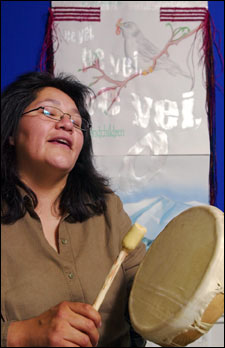Geri Barney:
Artist, musician

If I just stay here near the road that is made for me,
It winds in and out of the four sacred mountains you see.
If I just stay here near the road that is made for me.
My Red road is my own, my Red road was made for me alone.
Beneath evergreens and aspen, through fields of swaying grasslands
– Is my Red road.
So goes the song “My Red Road,” written by Geraldine Barney, course pack coordinator at Harvard Printing and Publications Services. Like many Native Americans, Geri has felt torn between the life and values she grew up with on the reservation and those of the surrounding world she has lived in since going to college. Trying to chart her own course has been the guiding principle in Geri’s life. The haunting songs she performs on guitar, flute, and hand drum, as well as the artwork she makes in the form of sketches, drawings, and prints, are her attempts to soothe herself, she modestly says, and find some peace in a conflicted world.
Geri grew up in Buffalo Springs, N.M., where her mom sowed the seeds for her daughter’s lifelong devotion to music by taking her to classical recitals in Gallup. Later, her uncle brought home a guitar, which Geri surreptitiously played while he was out. In middle school, she took up trumpet and then played tuba with the Navajo Nation marching band, eventually joining the Gallup Symphony Orchestra.
Just as Geri straddles two cultures, she simultaneously pursues paths in art and music, refusing to characterize herself primarily as a visual artist or a musician. At the Institute for American Indian Arts in Santa Fe, she studied native arts, including graphic design, printmaking, and music. When she began to study the Native American flute, she incurred her instructor’s disapproval for playing what traditionally had been a male instrument. But as an ethnomusicologist who knew that the flute had nearly disappeared along with its Native American players, and confronted with a diligence that would not be deterred, the teacher took Geri under his wing and had her accompany him at concerts.
At the Kansas City Art Institute, Geri pursued the visual arts, particularly printmaking. After graduating, she applied to Berklee College of Music, was accepted, and came to Boston. Once here, she could not meet tuition expenses, and had to defer. Despite lack of funds and culture shock, Geri persevered. She didn’t want to disappoint herself and her immediate family, but more importantly, she saw herself as a role model for her younger cousins at home.
Geri began working at a group home for the mentally ill, teaching computer skills and graphic design. When she realized how much she missed printmaking, she took a job at a press in Brookline, where she stayed for three years before finally coming to Harvard. At Harvard Printing and Publications Services, it’s Geri’s responsibility to organize the material excerpted from books and articles that is then copied and distributed to students as part of their coursework.
Geri recently gave a concert at Dudley House. After the performance, she was asked by two different Native American men, separately, “When are you going back to the reservation?” and “Where is all your silver and turquoise?” For Geri, the questions reflected how insecure Native Americans can feel off the reservation, as well as an anxiety around losing the accouterments that help define one’s cultural identity.
Geri’s songs have been recorded on two CDs: “Heartbeat, First Nations’ Women” and “Music of New Mexico: Native American Traditions,” both on the Smithsonian Folkways label. She recently traveled to Washington, D.C., to perform at a Department of the Interior celebration for Native American Awareness Day. Walking slowly through the Hall of Flags, ablaze with the colors of some of the 700 recognized native tribes extending from Alaska to Florida, Geri was struck by the diversity and breadth of Native American culture.
She may still feel the tension of treading between two worlds, but more and more, she is feeling the soundness of her path, her own Red road, winding in and out of the four sacred mountains.




